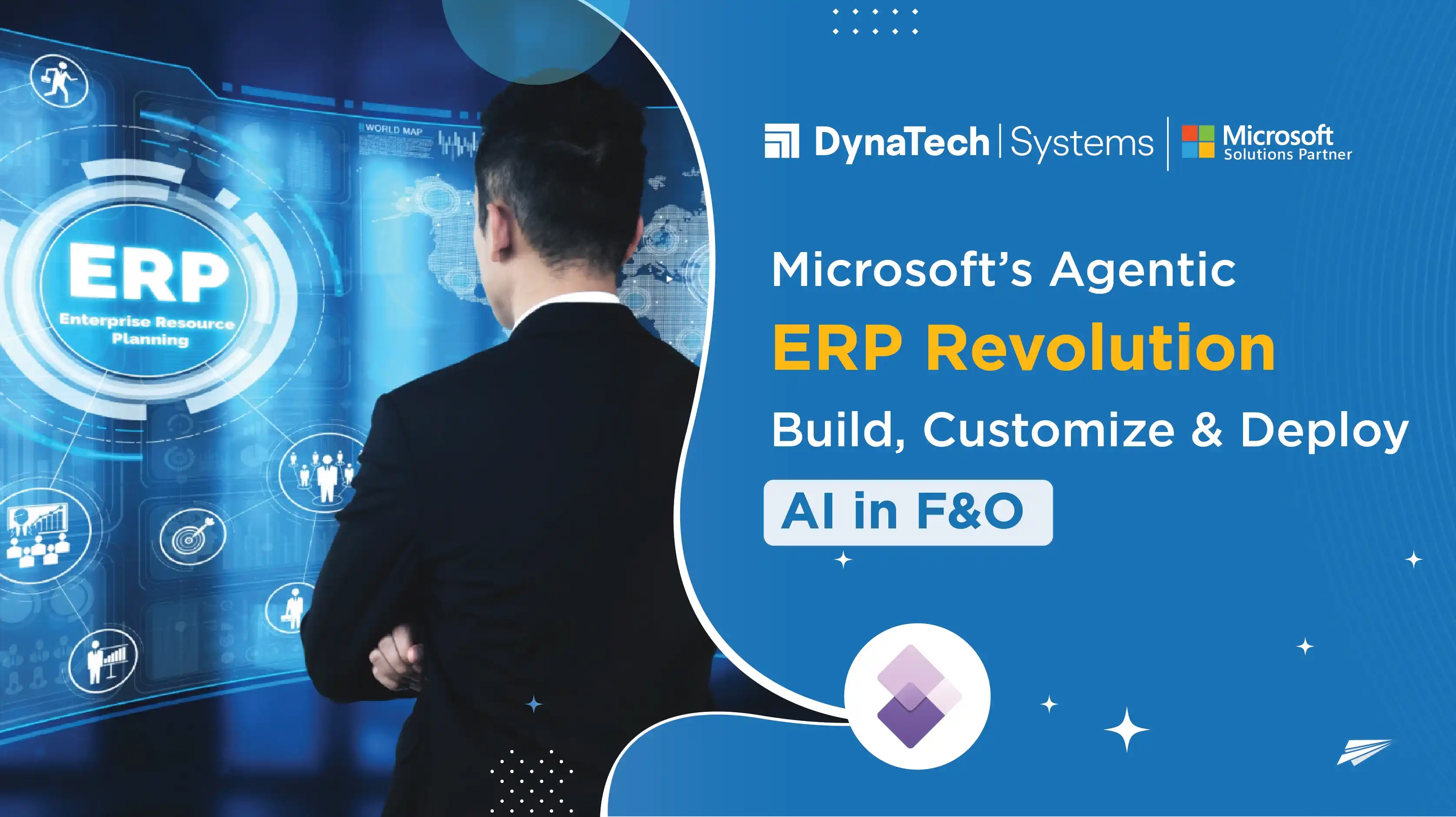ERP Has a New Brain: Welcome to the Age of Agentic ERP in Dynamics 365
There’s a shift happening — not in dashboards or forms, but in intelligence.
The Microsoft Dynamics 365 ERP platform is evolving into something far more autonomous, personalized, and proactive.
At the center of this transformation is Agentic ERP — a new generation of ERP capability that doesn’t just record transactions but but actually drives decisions. By leveraging Copilot, Microsoft is empowering users to create custom, AI-powered agents that deeply understand their business, respond in context, and act independently across Finance and Operations.
Whether it’s an agent that reconciles accounts or one that manages supplier communications, this is ERP that learns your data, adapts to your logic, and grows with your processes. And now — with Copilot Studio, MCP servers, and virtual entities — anyone in your organization can craft these experiences with little to no code.
This isn’t the future. It’s already running in environments just like yours.
What is the Agentic ERP Platform?
The term Agentic ERP Platform might sound futuristic — but it’s already reshaping how businesses interact with their core finance and operations systems.
At its core, Microsoft’s Agentic ERP approach transforms ERP from a system of record into a system of intelligence. It’s not just about processing transactions — it’s about making decisions, automating actions, and engaging users with context-aware, reasoning-driven AI agents.
These agents are built on three foundational layers:
|
Component |
What It Does |
|
Copilot Adaptive Experience |
Creates personalized, conversational experiences inside Finance, Supply Chain, and other operational modules |
|
ERP Agent Foundation |
Includes Microsoft’s built-in agents (1st-party), partner-developed agents (3rd-party), and fully customizable customer agents built via Copilot Studio |
|
Agent Business Services |
A robust services layer that connects agents to real-time ERP logic — such as validations, workflows, transactions, and data analysis |

With these layers working in harmony, businesses can create agents that:
- Understand operational policies and data models
- React to real-time business events
- Complete tasks or multi-step workflows autonomously
This structure is designed not only for Microsoft’s native use cases — but also for you to build on top of, using your own industry logic, compliance needs, and operational flow.
The Spectrum of ERP Agents: From Simple Queries to Autonomous Decision-Makers
Not all AI agents are created equal — and they’re not meant to be.
Microsoft’s Agentic ERP framework in Dynamics 365 allows businesses to work with agents across a flexible spectrum — from basic information retrieval to full-blown autonomous workflows. This allows organizations to start small, test value, and scale intelligently.
Here’s a look at the three levels of agents available in this spectrum:
|
Agent Type |
Core Capability |
Examples |
|
Retrieval Agents |
Pull relevant ERP data and respond to questions contextually |
“What’s the delivery date for PO #2543?” |
|
Task Agents |
Execute single-step actions triggered by user or system events |
Approving an expense report or validating a requisition |
|
Autonomous Agents |
Perform complex workflows and make decisions across multiple steps |
Consolidating POs, reconciling accounts, or handling supplier communication |

This modular architecture means you don’t have to leap into complex automation from day one. Start with retrieval use cases, layer on task automation, and graduate to autonomous agents that learn, adapt, and act — all with your ERP’s business rules and compliance guardrails in place.
The result? An ERP that doesn’t just inform — it performs.
Microsoft’s Pre-Built ERP Agents
You don’t need to start from scratch to experience the power of Agentic ERP. Microsoft has already shipped a set of production-ready agents embedded within Dynamics 365 Finance & Operations — designed to handle high-impact, repetitive tasks across core functions.
These agents are built using Microsoft’s ERP Agent Foundation, and they work seamlessly with your existing data, rules, and processes.

Here’s a snapshot of agents available today:
|
AI Agent |
Function |
|
Time Agent |
Automates time capture, tracking, and reporting |
|
Expense Agent |
Reviews expense claims, validates against policies, and initiates approvals |
|
Approvals Agent |
Handles purchase approvals, time approvals, and workflow escalations |
|
Supplier Communication Agent |
Engages vendors, sends queries, and manages responses autonomously |
|
Account Reconciliation Agent |
Matches ledger entries, flags discrepancies, and automates closing tasks |
|
Scheduling Operations Agent |
Plans production and operational sequences based on constraints and resources |
These agents are built to interact directly with ERP data, understand your policies, and act with reasoning. Even more compelling? They can be extended or customized using Copilot Studio to reflect your organization’s structure, rules, and terminology.
This gives you a foundation to experiment, refine, and scale — without waiting for IT backlogs or custom dev cycles.
What Really Happens Behind the Scenes of an AI Agent?
If you’ve ever wondered how an AI agent in Dynamics 365 F&O goes from “understanding a message” to “taking an action,” here’s a peek under the hood — in plain English.
These agents aren’t just fancy bots. They’re structured systems that follow a well-defined flow — taking input, running through a reasoning engine, and then producing meaningful results. But unlike traditional workflows, they’re designed to think with context.

Let’s break that down into three parts:
Step 1: It All Starts with a Trigger
An agent springs to life when something prompts it. This could be:
- A user asking a question like “Do we have this product in stock?”
- A system event, such as a new requisition being submitted
- Or even a message from another agent, passing along data or instructions
No matter the source, the trigger gives the agent its cue to begin processing.
Step 2: The Agent Thinks Before Acting
Once activated, the agent doesn’t blindly follow steps. Instead, it reasons through the situation using a mix of tools:
- A language model (LLM) helps the agent understand human input, parse intent, and stay conversational
- Instructions give the agent rules to follow — for example, “Don’t approve expenses above $10,000 without a manager override”
- And tools — such as plugins, retrieval APIs, or ERP functions — let the agent actually do something with the data
Depending on what it’s solving for, the agent might:
- Pull data (a retrieval call)
- Initiate a process (an action call)
- Or access structured knowledge (a knowledge call), like policy documents or virtual entities
This is where things get interesting — because the agent can blend your real ERP logic with natural language, business constraints, and contextual memory.
Step 3: It Delivers Something Useful
After thinking through the problem, the agent responds.
- Sometimes it just sends a reply — like “This PO is scheduled to ship on July 15.”
- Other times, it executes a backend action — like submitting a consolidated purchase order or scheduling a production task.
It’s not just answering questions. It’s solving problems.
Why This Matters
Traditional ERP systems wait for people to push buttons. Agentic ERP doesn’t wait — it responds, reasons, and acts in real time. More importantly, you’re not locked into rigid flows. These agents are modular, explainable, and can be adjusted without reworking your entire system.
That’s what makes them different — and powerful.
Building Blocks of AI in Dynamics 365 F&O: What Makes These Agents Tick?
So, how do you actually build one of these smart agents inside your ERP? Surprisingly, it’s not as complex as it sounds — and you don’t need a background in machine learning or a room full of developers.
Microsoft has made it incredibly approachable with a set of low-code AI tools, which allow both technical users and business users to customize AI experiences in Dynamics 365 F&O. Whether you want your agent to answer supplier questions, validate policy rules, or suggest order changes — it all starts with a few foundational pieces.

Low-Code Components You’ll Work With
Let’s talk tools. When building an agent, you’ll typically work with:
|
Component |
What It Does |
|
Topics |
Define the “subjects” or conversation areas the agent should cover |
|
Prompts |
Give the agent guidance on how to respond or take action |
|
Agent Flows |
Define the logic, conditions, and steps the agent should follow |
|
Connectors |
Bridge the agent with other systems — ERP data, external APIs, etc. |
These pieces aren’t just techy features. They give you a way to inject your business logic, structure conversations, and define what “smart” looks like inside your organization.
The Role of ERP Data and Virtual Entities
What gives these agents their true power is access to your real-world ERP data — and the logic behind it.
- Virtual Entities act as knowledge sources that the agent can reference
- Business Events trigger workflows or decisions in response to real-time actions
- Client Plugins & AI Plugins extend functionality, handle edge cases, or enforce rules
- ERP Knowledge Models allow the agent to reason the same way your business does — not how a generic chatbot might
For example, if someone searches for “MSERP” inside Copilot Studio, the platform can surface all virtual entities in that environment — such as invoices, products, vendors, and POs — and make them available as knowledge sources for the agent.
This means your agent doesn’t just answer “Is this item in stock?” It can understand where it’s stored, whether it’s reserved, and if it can be rerouted to a higher-priority order.
You’re Not Just Training an Agent — You’re Teaching It Your Business
The real value here isn’t just automation. It’s about giving the agent context. With the right setup, your AI assistant doesn’t just respond like a tool. It reasons like a teammate.
This level of contextual awareness is what sets Microsoft’s Copilot Studio and Agentic ERP apart. You’re not using a one-size-fits-all model. You’re creating an ERP-native, business-aware, low-code AI system — with your logic, your data, and your goals at the center.
Real-World Example: Maya and the Procurement Agent
Maya, a procurement specialist in a healthcare organization, is constantly juggling supplier selection, policy compliance, and urgent requisitions. But now, she’s supported by a Procurement Agent built in Copilot Studio — one that understands her ERP data and acts autonomously.
Automating Requisition Review
As soon as new requisitions come in, the agent checks them against company policy — no delays, no manual checks.

The AI agent automatically enforces procurement rules on incoming requests.
Smart Supplier Selection
It evaluates inventory, delivery timelines, cost, and risk — and if the same supplier fits multiple items, it consolidates them into one PO.

The agent finds the best supplier and groups items into a single purchase order.
Zero-Touch PO Creation
The agent issues purchase orders, tracks updates, and flags issues — all without Maya lifting a finger. PO creation happens end-to-end without manual intervention.
How to Build a Procurement Agent in Copilot Studio – Step-by-Step
With Copilot Studio, creating your own ERP agent doesn’t require code, custom dev, or weeks of configuration. In just a few clicks — and using the power of Microsoft’s ERP Agent Foundation — you can build, deploy, and scale intelligent agents that automate real tasks in Finance & Operations.
Let’s take the example of a Procurement Agent that reviews requisitions, finds suppliers, and issues POs.
Step 1: Describe the Agent’s Objective
The process starts with a simple prompt. A user can type a simple instruction like:
“Create an agent that will review requisitions, check policy compliance, find the best suppliers, and issue purchase orders.”

Begin by describing what your agent should do — Copilot Studio converts this into an AI-powered workflow.

Step 2: Define Capabilities & Reasoning
After naming the agent, you’ll select specific logic blocks and capabilities. These could include ERP policy checks, validation steps, supplier lookup logic, and PO generation — all managed through the MCP server.
The MCP server acts as the backbone — coordinating what actions the agent can take and what data it can access. You can even plug in partner-built MC servers to connect with other systems.

Step 3: Publish & Go Live
Once everything is configured, simply hit Publish. Your agent is now live — fully integrated with Dynamics 365, and ready to handle real procurement workflows.

Publish your agent instantly and roll it out across your organization.
From Requisition to Fulfillment — Autonomously
With the agent deployed, it can now transform:
- Requisitions into purchase orders
- Tasks into outcomes
- Manual effort into intelligent automation
Whether you’re in healthcare, manufacturing, or distribution, this level of automation can dramatically reduce cycle time, improve compliance, and free up your team for higher-value work.
Final Thoughts: From Copilot to Co-Worker
AI in ERP isn’t just a futuristic concept anymore — it’s already changing how real businesses operate. From reviewing requisitions and managing suppliers to taking autonomous action based on real ERP data, Microsoft’s Agentic ERP model isn’t just smart — it’s actionable.
And the best part? You don’t need months of development or deep AI expertise to get started. With tools like Copilot Studio, you can build intelligent, policy-aware, and contextually rich ERP agents in just a few steps — all using your own data, logic, and processes.
DynaTech being a Microsoft D365 Partner empowers enterprises like yours to unlock the full potential of AI in Dynamics 365 Finance & Operations — whether that’s through building custom agents, configuring ERP plugins, or integrating Copilot across business functions.
We’re not just implementers — we’re architects of adaptive intelligence for modern ERPs.
Ready to Build Your AI Agent?
Let’s co-create AI experiences that actually move your business forward.
Screenshot Image Source: https://l1nq.com/6YEM1




























